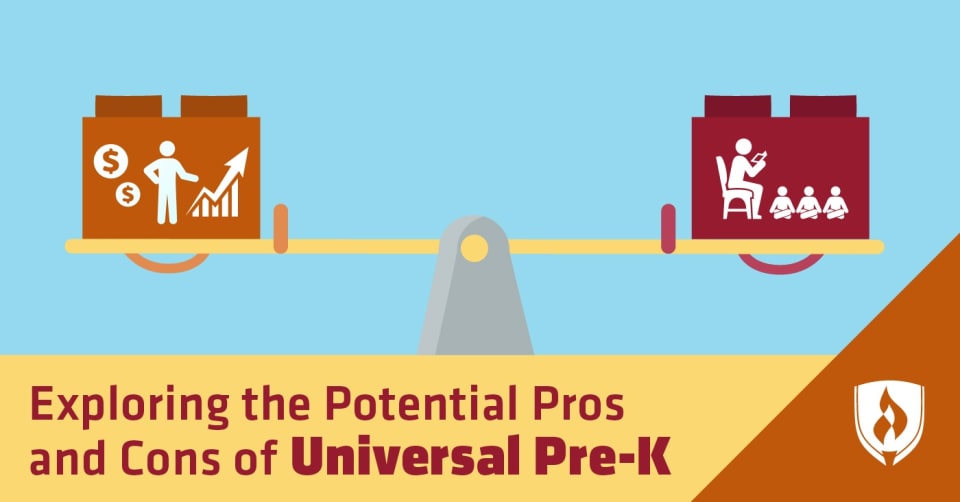
Chances are that you’ve heard the term “universal pre-k” if you’re a parent, teacher or childcare provider. This buzzword has been sweeping early childhood education headlines for a few years. The national discussion of universal pre-k is picking up steam, and as someone interested in an ECE career, you still have some questions about it.
What is universal pre-k? How does it differ from the current preschool options? What are the pros and cons for students, parents and teachers?
Early childhood education provides a vital foundation to children’s learning journeys, so it’s important to understand what universal pre-k entails. Join us as we dig into the research and hear from an early childhood education expert about the pros and cons of universal pre-k.
What is universal pre-k?
The short answer is that universal pre-k would operate similarly to other forms of public school: all children would have access to a high-quality preschool program, regardless of their family’s income.
This is an expansion of what is currently offered, in which most states offer some form of government-funded pre-k to families based on income. Universal pre-k would guarantee that all children have the opportunity to begin their education on a level playing field, with easy access to a high-quality ECE program.
Publicly funded preschool for all children sounds pretty great. However, implementing universal pre-k is no small undertaking. Although universal pre-k is in widespread use in other countries, only a handful of U.S. states currently offer it. This type of program would mean a major change for early childhood education in the U.S.—and any large shift is bound to come with its ups and downs.
Potential drawbacks of universal pre-k
Implementing a program like universal pre-k can come with some downsides. Here are a few of the drawbacks that could accompany this approach to ECE.
1. Funding can be a challenge
Providing high-quality early childhood education isn’t cheap. The U.S. spends far less on early childhood education than other countries, according to the Center for American Progress. Where Luxembourg spends $16,000 annually per child, state-funded preschools in the U.S. at the time of publication averaged only $4,143 per student.1
While a viable universal pre-k program may not require per student funding that matches Luxembourg’s, there is still a substantial cost that comes from expanding the total number of students overall—and there’s a lot of room for growth. According to Child Trends report, 47 percent of 3-5 year-olds in the US are not enrolled in a preschool program as of 2017.2 The American Institutes for Research (AIR) points to “a lack of sustained and reliable funding” as one of the main barriers to making universal pre-k a reality.3
2. Teachers may face increased pressure
No one really knows what regulations might exist around a universal pre-k program in the U.S. But the government-funded Head Start program is an example of what may be required for a program to maintain its licensing and funding. Head Start teachers are often required to perform more observations and assessments to maintain their high-quality standards. Creating a high-quality learning environment is obviously a good thing, but it can lead to teacher burnout if they’re not given proper support or the legislation is poorly crafted.
Nonprofit Quarterly noted that pre-k teachers in New York, where full-day pre-k is provided to children as young as three years old, were often paid much less than teachers with equal education and experience who worked in the public elementary school system. This made the program more affordable for the state, but it was teachers who paid the price. While this issue may be resolved somewhat with enough funding, this is a good example of where policy can fall flat.
3. Traditional home childcare providers may suffer
Universal pre-k would turn the care of preschool-aged children into a more formal educational experience. That could mean bad news for traditional childcare providers, who often rely on those age groups to keep their programs profitable.
A policy brief from the National Institute for Early Education Research (NIEER) delves into the possibility that universal pre-k could lead to a decrease in quality and availability of other forms of child care.4 Strict limits on the number of infants and toddlers a single provider can care for put in-home providers in a tough spot. Without older children to fill their programs, these providers may struggle to keep their doors open. Furthermore, the most-qualified teachers may be tempted to leave childcare centers in favor of universal pre-k programs.
Potential advantages of universal pre-k
There may be some logistical and financial drawbacks to universal pre-k, but there are also real advantages to children’s education that just might tip the scales. Advocates of universal pre-k believe these benefits outweigh the negatives.
1. More children could have access to high-quality education
Preschool programs in their current form can be cost prohibitive for many families. Data from Child Trends shows that children from families with higher incomes were more likely to be enrolled in a full-day pre-k program.2 This isn’t surprising, considering a median annual cost of $6,500 for a four-year-old, according to the Brookings Institution.5
“Universal pre-k allows children of all socioeconomic and racial backgrounds the opportunity to attend well-designed, high-quality preschool,” says teacher and Zivadream education advocate Debbie Lopez. This means children who may otherwise have been at a disadvantage—such as those learning English as a second language or those from lower-income households—can receive the same kindergarten readiness as other students.
2. It can help close the quality gap
The quality gap in early childhood education has been a problem for years. States have differing ECE regulations—and many of them don’t meet best practices for a high-quality pre-k program. The quality gap can also be seen in private preschool and childcare programs that sometimes don’t receive much direction in best practices from their state.
Implementing universal pre-k would be an opportunity to standardize regulations such as licensing requirements and professional development programs for teachers. The Quality Rating and Improvement System (QRIS) was developed in the 1990s to help child care providers achieve accreditation. These gold standards of early childhood education could be implemented on a wider scale if universal pre-k comes to pass.
3. Classrooms could be more diverse
More accessible pre-k programs mean a wider array of diversity in the families who enroll their children. “These diverse learning environments provide opportunities for children to gain new perspectives and appreciate their uniqueness while fostering empathy and inclusion along the way,” Lopez says.
Children growing up with a more inclusive perspective is just one benefit of diverse classrooms. Another is the opportunity to close the achievement gap that’s often present between White children and children of color. The National Association of the Education for Young Children (NAEYC) writes that “the achievement gap results from the inequitable opportunities provided to our children, families, and communities. As a nation, we could— and should—do far more to equalize opportunities to learn.” Universal pre-k provides the ability to do just that.
4. Parents can be more involved in their children’s education
“Parents tend to see universal pre-k more as an education than preschool or daycare,” Lopez says. Rather than thinking of their kids blowing bubbles and finger painting all day, parents are more likely to view government-funded pre-k as a steppingstone to kindergarten readiness.
Lopez says this type of learning environment can give parents a nudge to get involved with their children’s education and learning goals earlier than they would otherwise. Parents who engage with their kids’ education are giving their children a boost both academically and socially—they help reinforce the critical language and social skills developed in early education programs. This type of positive parent involvement is a benefit that shouldn’t be overlooked!
The importance of pre-k
The pros and cons of universal pre-k are still up for debate, but one thing that’s crystal clear is the importance of early childhood education in preparing young children for learning in kindergarten.
Pre-k teachers are essential to creating high-quality programs that serve children well. Learn more about why this vital stage of learning sets the stage for children’s futures with our article, “5 Reasons Why the Importance of ECE Is Impossible to Ignore.”
1Center for American Progress, The United States Is Far Behind Other Countries on Pre-K [accessed August 2020] https://www.americanprogress.org/issues/early-childhood/reports/2013/05/02/62054/the-united-states-is-far-behind-other-countries-on-pre-k/
2Child Trends Databank, Preschool and Kindergarten, [accessed August 2020] https://www.childtrends.org/indicators/preschool-and-prekindergarten
3American Institutes for Research, Policy Center: Five Things We Can Learn From Pre-K in Other Countries [accessed August 2020] https://www.air.org/resource/five-things-we-can-learn-pre-k-other-countries
4National Institute for Early Education Research, Perspectives on the Impact of Pre-K Expansion, [accessed August 2020] https://nieer.org/wp-content/uploads/2016/08/22.pdf
5The Brookings Institution, What Is the market price of daycare and preschool? [accessed August 2020] https://www.brookings.edu/research/what-is-the-market-price-of-daycare-and-preschool/




